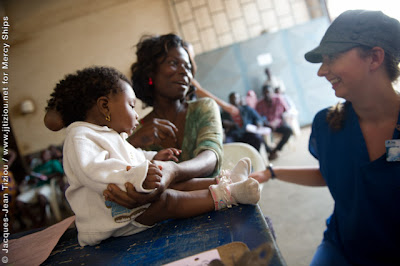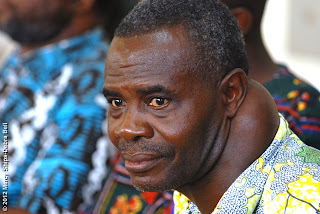Screening day.
As a transitory organization that meanders from country to country like a band of gypsies, we have some exceptional challenges that stationary organizations, hospitals, and clinics don’t face. If you are permanently at an address, those with medical needs come to you. They know where you can be found.
Word gets out – and spreads its way across the nation like oxygenated blood – flowing through the rainforests, across the savanna, and from person to person through the endless transactions of water sachets, motorbike taxi rides, rice and street meat purchases.
Mercy Ships has to make the most of our time by getting the word out quickly in hopes to be able to complete all steps during our short stay: locate the patients, assess their medical condition, match them up with our surgical schedule, perform the operation, allow them time to have therapy, heal and recover before we head on our way to the next port.
Mass screening day has become a very key component in this process. Using several radio stations, we attempt to get the word out quickly and to as many as possible providing the answers to all the questions.
Last Wednesday, February 1st was the day we had been preparing for.
The first crew left the ship the day before – we set up the chairs, tables, walked through the logistics of the stations, what if scenarios, and began final preparations.
Wednesday morning departures started at 4:00am, while it was still dark. Even with abbreviated sleep, the excitement and anticipation for the day was palpable.
We drove in convoy formation through the town and arrived shortly after 5:00 in the morning. The line of people who waited over night numbered in the thousands already.
Even us non-medical people have a place at screening day - data entry is an important step in the process as they are issued their patient ID numbers, given a card with their information on it that allows them entrance into the port.
The Gendarme are present to assist with security.
And as the sun comes up, the line continues to grow. An estimated 3500 in total were queued.
Our own crew helped with security (as well as a little entertainment). In the case of this little girl, she was terrified of this big YOVO (white man).
Keith is the man at the gate - with the little paper ticket they prove they entered through the appropriate gate (an issue we worried about since the entire perimeter has a short fence and could have been breached easily).
While they wait in line, the kids receive special attention- bubbles, chalk, drawings, puppets and the like.
Water is distributed to all waiting in line - Coca-Cola West Africa partnered with us for this event and provided 3000 bottled waters to collaborate with us.
Dan was in charge of overseeing all medical logistics for the day - a big job with lots of people to manage.
- Pre-pre-screeners: work the line outside of the stadium compound identifying those with conditions we are unable to treat.
- Pre-screeners: once they come into the gate, they are assessed by a medical team to determine if this condition is something we are equipped and able to address.
- Registration: working with the help of translators, we record each potential patient’s personal contact information.
- Histories: nurses work with our translators to take medical assessments of each patients – blood pressure, temperature, pulse, history of the illness/condition.
- Specialities: the patients are sent to their respective areas – maxillo-facial tumors, cleft lips/palates, or bumps head to the Max-Fax Room, burn victims or those with keloids to the Plastics Room, hernias, goiters and lipomas to the General Surgeon’s Room, and women with vaginal fistulas were directed to the VVF Room. In each of these rooms they are seen by surgeons and or doctors who are further able to determine the need for surgery, cause of condition, and what the next step of treatment should be.
Another potential stop after the speciality surgeons is the lab - some blood is drawn on site and taken back to the ship's lab with the next returning vehicle for it to be processed.
Biopsies are another crucial step in determining if the tumor or growth is something we are able to treat. In a regular sized hospital you may do 1-2 biopsies a day. Our team did 40 on screening day!
While many people come with medical issues not visible on the surface, others are obvious. For some, coming to screening is the bravest thing they have done in years - hiding behind the curtains of pitch black night, foraging for food in the dark, and staying out of sight for shame of their condition.
Also onsite were our photographers, videographer, and writers as a big part of Mercy Ships is getting the word OUT so people can help share the burden.
Baby Simi Julie getting ready for her pre-operation photo.
She's gorgeous, cleft lip or not. (She's actually already had her surgery!)
At any point in this process, if the answer is “no surgery,” we inform the hopeful patient and direct them toward the prayer team, waiting with open arms to pray for them, embrace them, and love on them.
So, we do what we we do with gladness...
Sunburn, and tired feet...
...and still some cousinly smiles at the end of the day...
...making sure no one gets left behind when all the vehicles depart.
For the chance to bring about a new way of life for her.
And him.
And him.
And him.
And this family too.












































AWESOME post Tiffany. My head and heart are reeling with pain, thanksgiving, and wonder at this amazing work of the Africa Mercy.
ReplyDelete